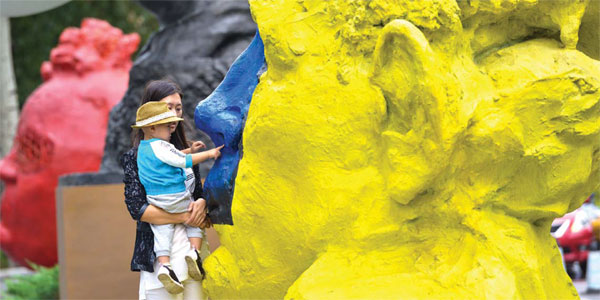Rise of the culture vultures

China's retail spaces blur the lines between art and commerce
In November the K11 Art Mall in Shanghai will host a Salvador Dali exhibition, the only Dali exhibition in China to be authorized by the Gala-Salvador Dali Foundation since 2001.
It is the second blockbuster show to be held in the retail development, the first being the Monet show last year that brought together 40 original art works from the French impressionist including the world-famous Water Lilies. It attracted about 350,000 visitors in three months. The average ticket price was 100 yuan ($15.7; 13.8 euros).
| A toddler and Gianni Dessi's sculpture Three for You which is exhibited outside the Parkview Green Mall in Beijing. Photos provided to China Daily |
| K11 Art Foundation chairman Adrian Cheng brought Monet to the masses during a three-month exhibition at the K11 Mall in Shanghai last year. |
"We made no money from Monet," says Douglas Kotwall of the K11 Art Foundation. "Most of the money went into things like insurance and logistics."
The foundation, which has its headquarters in Hong Kong, is blurring the lines between culture and commerce. There is art in the Shanghai mall's 3,000-square-meter basement and art in the shopping areas, too. Adrian Cheng, an art collector and head of the foundation, has previously stated that he wants to bring art to the masses.
China is not short of places to enjoy art. The government said it wanted 3,500 museums by 2015, a goal it reached three years ahead of schedule, with Beijing and Shanghai having the lion's share of institutions.
Of the country's 1,560 art galleries in 2013, 742 were in the capital. A fraction specializes in contemporary art, Chinese or foreign. No Chinese mainland museum is in The Art Newspaper's top 10 list for visitor attendance; Europe dominates the rankings although National Palace Museum in Taipei holds steady at seventh place. It organized the top three best-attended exhibitions in 2014, with more than 12,000 visitors a day enjoying the work of Tang Yin (1470-1524). A similar number of people visited a show about emperor Qianlong (1711-99) of the Qing Dynasty (1644-1911), which included 45 pieces loaned from the Palace Museum in Beijing. Half of the Taipei museum's visitors are from the Chinese mainland and one-third are locals, say The Art Newspaper. Shanghai Museum's free exhibition Tracing History last year attracted 629,233 visitors in just under three months, making it the 13th most visited exhibition in the world last year, according to the publication.
An omission from the list is the Palace Museum in Beijing, which had more than 15 million visitors in 2014.
"But, as in previous surveys, we have treated it as a special case. Situated in the Forbidden City, it is part of a larger visitor destination and so it is difficult to compare it with a standalone institution," the newspaper says.
The Louvre welcomed 9.26 million visitors in 2014, with foreign visitors representing 69 percent of ticket sales. About 7 percent of its visitors came from China, the museum says. So there is a Chinese appetite for art, whether it is at home or abroad.
"The visitor numbers we got for Monet are probably more than most (Chinese) museums see in a year. That's a reason for putting it in a commercial space," Kotwall says. "People in China are unfamiliar with going to a museum or gallery. But they'll go to a mall every weekend. That's one of the missions we have - public art education. The Chinese are craving new culture and new things. For Dali we are having a parallel show, with established and emerging Chinese contemporary artists, to show the influence of surrealism."
Kotwall says people who attend K11's shows are interested in art and want to learn about it. "They are educated, they have gone overseas and have come back. The next level of lifestyle for them is art. Art connects them to the outside world."
K11 is planning 19 Chinese projects based on its art-retail model. The biggest will be in Shenyang, capital of northeast China's Liaoning province, at 260,000 square meters of space.
Other retail developments are also attempting to broaden the cultural experience in China, standing out in a crowded marketplace by organizing exhibitions of conceptual art and photography. Beijing's fashionable Taikoo Li Sanlitun hosted prize-winning architect Frank Gehry's first exhibition in China in 2010 and this month is showing Now Is The Time, a collaboration with the prestigious Magnum Photos agency.
Some retail spaces retain a museum-like feel, with the work on the wall and the consumer in front of it. Beijing's Parkview Green presents a more personal approach. On an overcast weekday afternoon, a young woman sits at the foot of Shen Jingdong's Salute while her friends take a photo. A security guard loiters but does not intervene. Elsewhere someone peers through the long pink threads of Yang Tao's Empty Bundle. Outside, people pet a pair of snarling bronze wolves and take selfies next to brightly colored and outsized statues of heads.
"Art attracts customers," says George Wong, chairman of the Parkview Group. "It helps to sell things. It's also an important opportunity to present art to the public. Most artists want their work to be seen. It is my wish to give the public an education in art. But I want them to touch it and interact with it. Painting is for your eyes only."
(China Daily European Weekly 09/25/2015 page7)
Today's Top News
- Japan tempting fate if it interferes in the situation of Taiwan Strait
- Stable trade ties benefit China, US
- Experts advocate increasing scope of BRI to include soft power sectors
- New engine powers cargo drone expansion
- China to boost green industry cooperation
- Manufacturing PMI rises in November
































